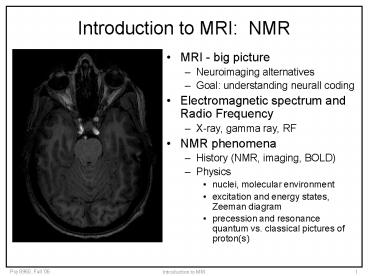Introduction to MRI: NMR PowerPoint PPT Presentation
Title: Introduction to MRI: NMR
1
Introduction to MRI NMR
- MRI - big picture
- Neuroimaging alternatives
- Goal understanding neurall coding
- Electromagnetic spectrum and Radio Frequency
- X-ray, gamma ray, RF
- NMR phenomena
- History (NMR, imaging, BOLD)
- Physics
- nuclei, molecular environment
- excitation and energy states, Zeeman diagram
- precession and resonance quantum vs. classical
pictures of proton(s)
2
Related readings
- Huettel, Chapter 1
- History, resonance phenomena described (pp. 11 -
22) - Definitions of contrast and resolution (pp. 6 -
11) - Example (of what I dont like pp. 12, 13)
- Buxton, pgs. 64 - 72, 124 - 131
- Haacke, Ch. 1, 2 25
3
Neuroimaging
Localization Timing Human studies Interpretation
Electrophysiology
Optical imaging
EEG electroencephalography
MEG magnetoencephalography
PET Positron emission tomography
fMRI functional MRI
4
Nuclei
5
Periodic table
6
Hydrogen spectrum electron transitions
1 electron volt 1.6 10-19 J
http//csep10.phys.utk.edu/astr162/lect/light/abso
rption.html
7
Magnets
Dipole-dipole interactions
Dipole in a static field
Lowest energy
Highest energy
Lowest energy
Highest energy
B
N S
N S
N S
N S
N S
N S
8
The Zeeman effect
- The dependence of electronic transition energies
on the presence of a magnetic field reveals
electron spin (orbital angular momentum)
http//csep10.phys.utk.edu/astr162/lect/light/zeem
an-split.html
9
Stern-Gerlach experiment
- Discovery of magnetic moment on particles with
spins - Electron beam has (roughly) even mix of spin-up
and spin-down electrons
http//www.upscale.utoronto.ca/GeneralInterest/Har
rison/SternGerlach/SternGerlach.html
10
NMR - MRI - fMRI timeline
1922 Stern-Gerlach Electron spin
1952 Nobel prize Felix Bloch, Edward Purcell NMR
in solids
1993 Seiji Ogawa, et al. BOLD effect
1937 Isidor Rabi Nuclear magnetic resonance
1902 Pieter Zeeman Radiation in a magnetic field
1973 Paul Lauterbur, Peter Mansfield NMR imaging
1936 Linus Pauling Deoxyhemoglobin electronic
structure
11
Single spin-1/2 particle in an external magnetic
field
Nucleus in magnetic field
Nucleus in free space
Spin-up and spin-down are different energy
levels difference depends linearly on static
magnetic field
All orientations possess the same potential energy
12
Resonant frequency, two ways
Spins in static magnetic field precess, with
? ?B or ? ?B where ?, ? precession
frequency (radians, Hz) ?, ? gyromagnetic
ratio (in rad/T or Hz/T) B static (external)
magnetic field (Tesla)
Transition from high to low energy state emits
radiation with characteristic frequency
- Proton gyromagnetic ratio
- ? 42.58 MHz/T
- ? 2?? 267,000,000 rad/T
13
Gyromagnetic ratio
14
Many spin-1/2 particles in an external magnetic
field
B
M net (bulk) magnetization
Excitation affects phase and distribution
between spin-up and spin-down, rotating bulk
magnetization
M
M
Equilibrium 1 ppm excess in spin-up state
creates a net magnetization
M?
15
Information in proton NMR signal
- Resonant frequency depends on
- Static magnetic field
- Molecule
- Relaxation rate depends on physical environment
- Microscopic field perturbations
- Tissue interfaces
- Deoxygenated blood
- Molecular environment
- Gray matter
- White matter
- CSF
Excitation
Relaxation
16
Proton NMR spectrum ethanol
/grupper/KS-grp/microarray/slides/drablos/Structur
e_determination
17
Water
www.lsbu.ac.uk/water/
18
Magnetic Resonance Imaging
- An MR image is (usually) a map of water protons,
with intensity determined by local physical
environment - Contrast and image quality are determined by
- Pulse sequence
- Field strength
- Shim quality
- Acquisition time

